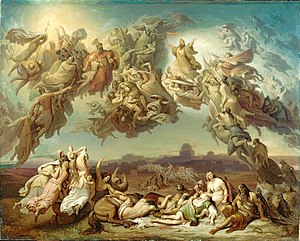Hunnenschlacht (Liszt)
Hunnenschlacht , Symphonic Poem No. 11 is a symphonic poem by Franz Liszt for an orchestra expanded by organ and percussion . It continues the tradition of the musical battle painting that emerged in the early baroque period. The approximate duration of the performance is 16 minutes.
The work was created around 1856/57 and was premiered on December 29, 1857 in Weimar . His program essentially depicts the slaughter between Huns and Romans .
To the music
Essential element of music is the chorale " Crux fidelis " which at the end of exposure , in the implementation and completion of the entire work as a musical symbol occurs. This chorale sounds first in the tenor and bass trumpets , later also on the organ, and symbolizes the Roman army . Furthermore, the use of trumpets as "battle cries" indicates that Franz Liszt dealt with the instrumental science of antiquity, since trumpets as " tubae " evidently existed in a similar form in Rome . Franz Liszt sees in his work not the struggle between two peoples, but the struggle between civilization and barbarism , between Christianity and paganism . The latter is expressed above all in the final chorale, which illustrates the victory of the Christians.
literature
- Harenberg, cultural guide concert . Meyers Lexikonverlag, Mannheim 2006, ISBN 978-3-411-76161-6 .
Web links
- Battle of the Huns (arranged for piano four hands) : Sheet music and audio files in the International Music Score Library Project
